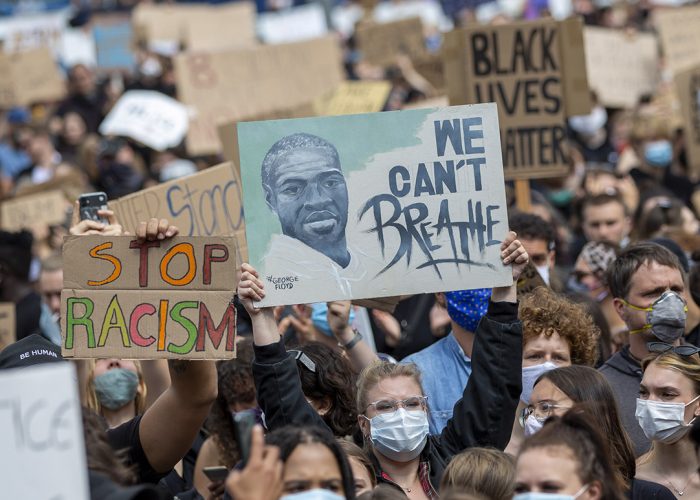“You don’t have to be a virologist or an epidemiologist or a physician to understand why this is a risk in the current day and age when” the novel coronavirus is still circulating,” said virologist Menno D. de Jong at the University of Amsterdam.
De Jong said people should be able to protest but even demonstrators need to maintain social distancing.
“People need to be able to show their opposition to what has been happening in the United States and their solidarity with the affected individuals,” Paul Hunter, a professor at the University of East Anglia in the U.K., wrote in a statement. But any mass gathering does pose a risk of increased transmission of COVID-19.”
Karl Lauterbach, a member of the German parliament for the center-left Social Democrats, tweeted a video of the demonstration in Berlin on Saturday and expressed concern that protesters weren’t keeping enough distance.
“The danger of the corona pandemic has not been averted,” wrote Lauterbach, a professor of health economics and epidemiology at the University of Cologne. “There were some super-spreader events outside too, in Italy and Spain. Racism must be fought, but without avoidable corona deaths.
Another virologist, Belgium’s Marc Van Ranst, put it simply: When it comes to coronavirus, these protests were “not a good idea.”
The protesters themselves seemed to be aware of the risks.
Carrie Xin Hou said safety was a “major consideration” that she and her partner weighed before deciding to attend the protest in Brussels Sunday. But the situation had improved dramatically from the height of the outbreak in March, she said, with the government announcing last week that bars and restaurants could reopen the day after the protest.
“If we’re going to go to something which requires taking a risk and going to a crowd … we’d rather it be a protest than going to a bar,” Hou said.
The need to stand in solidarity with anti-racism protests in the U.S. is why, after considering the health risks, Bruna Campos also went to the protest in Brussels.
“That’s also the point: People showed up to a protest because of how dire the situation is,” Campos said.
Paola Verhaert and a friend came prepared to the protest in Brussels they brought extra face masks and hand gel to give out.
“To our delight, very few people were not wearing face masks and needed to receive one from us,” Verhaert said.
Verhaert and two other protesters told POLITICO that they were able to maintain distance from people they didn’t know, and tried hard not to accidentally touch someone else.
There were also some factors working in protestors’ favor, said de Jong.
The protests were outdoors and wind and warm weather would likely have helped slow any spread of the virus. Even a large protest under these conditions would be better than a hundred or so people packing into a confined space like a bar, he added.
But he’s concerned that face masks give people a false sense of security. If someone is infected and shouts, small droplets of spit can “traverse a self-made mask,” he noted.
Another key measure that has helped slow the infection has been staying apart 1.5 or 2 meters depending on the country from other people. That wasn’t completely possible in the protests.
“There is clear evidence that banning mass gatherings was one of the most effective and important part of the lockdowns across European countries,” Keith Neal, an epidemiology professor at the University of Nottingham in the U.K., wrote in a press release. “Any mass gathering risks significant numbers of further cases.”
It “needs to be considered” that black, Asian and minority ethnic people are at a higher risk of COVID-19 complications, he added.
De Jong noted the organizers of the solidarity protest in Amsterdam marked spaces 1.5 meters apart for hundreds of people. But once thousands showed up, that was ineffective. These large numbers also mean contact tracing will be difficult if someone gets infected.
The exact effect of the protests across Europe is not certain, he said that will emerge only in two to three weeks: “That’s why we need to be on guard.”
Having thousands of people protest had one positive health impact, Hou argued. The protests provided “a huge sense of community,” and “it was quite healing for some people’s mental health.”
Some protesters said they are going to self-isolate for two weeks or decrease the number of people they will see, even if governments are loosening restrictions.
Public health experts, meanwhile, have released some guidance on what to do during protests. The World Health Organization on Monday said protesters should maintain at least a 1-meter distance, wash their hands, cover their mouth if they cough, and wear a face mask.
Hunter said no one over the age of 60 or with symptoms should attend a protest, while police should “avoid forcing crowds into tightly packed areas as this will cause even greater risk of disease transmission.”
But experts realize the need to protest was too great for some.
The Belgian government’s epidemic contact-tracing strategy, Emmanuel André, tweeted Sunday that if racism didn’t exist, 10,000 people wouldn’t have had to remind Brussels that we are all equal. To these people, I ask them to strictly respect [read more] for 15 days and to continue their fight all their life.
Still, Campos said, the feeling in Brussels was “magical” on Sunday.
“For the last 11 years in Belgium, I didn’t feel like this,” she said. “Today I kind of feel like there’s hope for Belgium.”
Ashleigh Furlong contributed reporting.
Protests ‘not a good idea’ when it comes to spread of virus, experts say


